|
Topics to be learn :
- Respiratory system
- Circulatory system
- Human Blood groups
Human Blood pressure
|
Introduction : Different organs in our body are working in group so as to smoothly carry out various life processes. These life processes takes place in various steps. Specific organs carry out the specific steps.
Life processes : For the survival of living being, some vital processes are essential. These processes along with the specific properties of living beings are known as life processes.
Organ system : Organs are made from the tissues. Organ systems are made up of organs which are performing similar type of functions. Group of organs working together to perform a specific function is called as organ system.
Different types of organ systems : Digestive system, respiratory system, circulatory system, nervous system, excretory system, reproductive system, skeletal system, muscular system are different systems present in out body.
Q. Which processes occur in our body during sound sleep?
Answer :
Many vital processes such as circulation, respiration, digestion, etc. take place even when we are asleep.
[collapse]
Q. Which different organs perform the function of breathing in the body of animals?
Answer :
- In case of mammals, nose, pharynx, larynx, trachea, bronchioles, lungs and alveoli are the organs that carry out function of breathing.
- Diaphragm and muscles connecting ribs too take important part in the breathing movements. Such organs are present in mammals.
- In case of aquatic animals there are gills for taking dissolved oxygen from the water.
- Birds and reptiles also breathe by lungs. In birds, lungs are connected to air sacs. Amphibians can breathe through lungs when on land as well as skin when in water. Different types of non-chordates breathe by different respiratory Organs such as spiracles, tracheae, book lungs etc.
- Very primitive animals breathe through cell membrane by diffusion.
[collapse]
Energy : Energy is essential to operate all the life processes in human body. Energy production occurs within the cells. Cells need the supply of soluble nutrients and oxygen for this. This supply takes place with the help of respiratory system, circulatory systems and digestive system.

Respiration :
Respiration is carried out through following three steps.
1) External respiration : :
1) External respiration :
- Intake of air from the outside into the body and release of air from the body to outside is called external respiration.
- Air is taken in through nose and sent towards the lungs through trachea (wind pipe).
- External respiration occurs between cells and the external environment.
- It involves processes of inspiration and expiration.
- External respiration involves breathing and gaseous exchange.
- Oxygen combines with haemoglobin in external respiration.
[collapse]
2) Internal respiration : :
2) Internal Respiration :
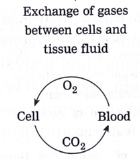
- Exchange of gases between cells and tissue fluid is called internal respiration.
- Internal respiration occurs only in the cells of the body.
- It involves movement of O2 from blood into tissue fluid and movement of CO2 from tissue.
- Internal respiration involves neither breathing nor gaseous exchange.
- Chemical reactions occur in the cells to form energy.
[collapse]
3) Cellular respiration : :
3) Cellular respiration :
- During respiration, the glucose molecules along with some other soluble nutrients are slowly oxidized with the help of oxygen in each cell.
- In this process the energy is released in the form of ATP, CO2 and water vapours are produced.
- These products are not needed for the body and hence given out of the body in exhalation.
- This process of cellular respiration is shown by the following reaction :
- C6H12O6 + 6O2 = 6CO2 + 6H2O + Energy (38ATP)
[collapse]
Organs present in the respiratory system :
Nose, pharynx, Larynx, trachea or wind pipe, lungs containing alveoli are the organs that form respiratory system. The air comes in the body through nostrils as well as also through the mouth.
(1) Nose : Beginning of the respiratory system. Tiny hair, cilia and mucus in the nose.
- Function : To inhale the air in and to exhale it out. The air is filtered here. The dust particles are trapped in the mucus. The air is made warm due to elongated path.
2) Pharynx : Beginning of trachea (wind pipe) and oesophagus (food pipe). Epiglottis covering the opening.
- Function : Due to epiglottis the food particles do not enter the trachea. Air is pushed forwards through pharyngeal region.
(3) Trachea : At the upper end there is larynx (sound box). The trachea bifurcates into right and left branch called bronchi.
- Function : To transport the inhaled and exhaled air to and fro, from the lungs.
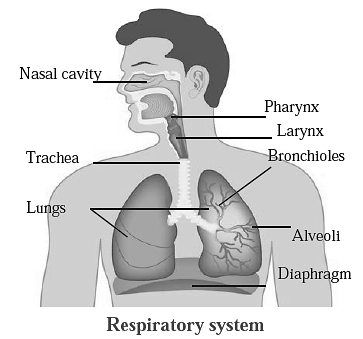
(4) Lungs :
(4) Lungs : Pair of lungs is the main respiratory organ in the human body. They are located in thoracic cavity. They are present on either sides of heart.
- Each lung has double layered pleural membranes.
- Trachea bifurcates into two bronchi. Each bronchus enters lung on its side and divide and re-divide into fine bronchioles.
- At the end of each bronchiole there is alveolus. Alveolus is surrounded by capillary network.
Working of Lungs:
- Each alveolus is extremely thin walled and hence gaseous exchange can occur through diffusion here. Due to thousands of alveoli, the lung surface is increased many a times.
- Deoxygenated blood coming from heart by pulmonary arteries is purified here in the lungs.
- It is mixed with oxygen due to gaseous exchange and returned back to the heart by pulmonary veins. Lungs thus continuously help in oxygenation of blood with the help of all of the alveoli.
Function :
- Elastic and spongy structures. Provides place for gaseous exchange. (O2 and CO2).
[collapse]
(5) Alveoli :
(5) Alveoli : Rich network of capillaries surround every alveolus. Their walls are extremely thin.
- Function : Gaseous exchange takes place in alveoli.
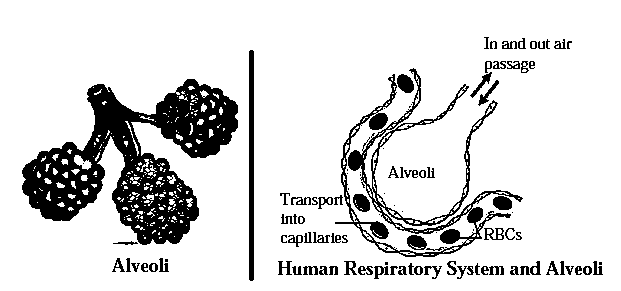
[collapse]
(6) Diaphragm :
(6) Diaphragm : Function : Movement of air in and out of the body caused due to upward and downward movements of the diaphragm.
- Diaphragm is a muscular partition that divides the thoracic and abdominal cavity.
- Located at the base of thoracic cage, it is very important in breathing movements.
Movements of Diaphragm :
- Diaphragm can undergo consecutive upward and downward movements.
- These movements along with movements of thoracic cage cause rise and fall of the pressure in the thoracic cavity.
- Rising up of ribs and lowering of diaphragm causes the decrease in air pressure which makes the air to move into the lungs through nose. This is inhalation.
- When the pressure rises in the thoracic cavity again, the air is given out. This is exhalation.
- This is caused due to ribs returning to their original position and rising diaphragm. This simultaneously increases the pressure in thoracic cavity.
[collapse]
Exchange of gases during respiration :
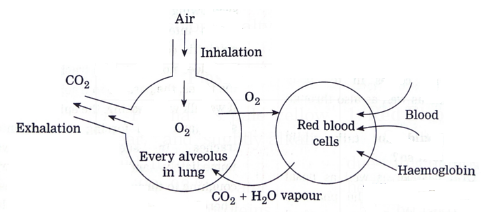
Q. One should not talk while eating. Why is it so?
Answer
Ans. Oral passage as well as nasal passage both open into the pharynx.
From this region the oesophagus (food pipe) as well as trachea (wind pipe) start.
At the beginning of these two tubes, there is a flap called epiglottis. When we are swallowing the food, the morsel of food enters into oesophagus. At that time epiglottis covers the trachea. Therefore food does not enter into trachea. Rest of the times, the passage to trachea is open.
If we talk while eating, the epiglottis may shake and open forcing the food into trachea. In such situations, we immediately and involuntarily start coughing to throw out the food particles. Therefore, one should not talk while eating.
Blood circulatory system :
The transport of gases or substances that are absorbed or synthesized from one region of the body to the other through the medium of blood is called blood circulation.
Organs in blood circulatory system : Heart, arteries, veins, blood capillaries, blood cells/corpuscles, etc. are present in the blood circulatory system. Out of this heart, blood vessels and capillaries can be considered as organs.
Transport of various substances by blood : Water, hormones, oxygen, soluble nutrients and waste materials.
Human Heart :
Human heart : Human heart is four chambered muscular organ.

- The size of the heart is about one’s own fist and its weight is about 360 gm.
- For protection, it is covered over by double layered pericardium.
- The wall of the heart is made up of cardiac muscles which are involuntary in nature. They have the capacity of rhythmic beating.
- The upper two chambers are called right and left atrium and lower two chambers are called right and left ventricle.
- Between right atrium and right ventricle there is tricuspid valve which guards the opening. Similarly between left atrium and left ventricle there is bicuspid valve.
- On entire right side of the heart there is deoxygenated blood.
- On entire left side of the heart there is oxygenated blood.
- Right atrium receives deoxygenated blood by superior and inferior vena cava.
- These two major veins bring deoxygenated blood from entire body to the heart.
- Left atrium receives oxygenated blood from lungs by pulmonary vein.
- Right ventricle sends the deoxygenated blood to lungs for oxygenation, through pulmonary artery.
- Left ventricle supplies oxygenated blood to entire body through systemic aorta.
[collapse]
Blood vessels : Heart is working (beating) continuously. Due to this, blood continuously circulates through blood vessels. There are three types of blood vessels:(a) Artery (b) Veins (c) Capillaries.
(a) Artery (b) Veins (c) Capillaries :
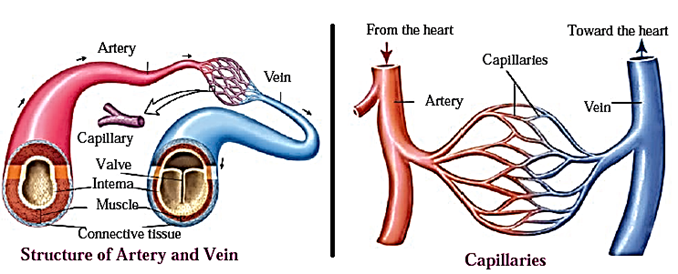
(a) Artery : Blood vessels which carry the blood away from heart are called as arteries
- Transporting blood from the heart to the body.
- Deeply located in the body.
- Walls are thick.
- No valves inside
- Transporting oxygenated blood (exception : Pulmonary artery)
(b) Veins : Vessels carrying the blood towards the heart from various parts of body are called as veins.
- Transporting blood from the body to the heart.
- Superficially located in the body.
- Walls are thin.
- Provided with valves.
- Transporting deoxygenated blood (exception : Pulmonary vein)
Valves in veins prevent the backflow of the blood. Blood in the veins is not under great pressure so it is likely that it may flow back. But valves prevent such movements.
(c) Capillaries :
- Arteries keep on branching out to form their branches and sub-branches, ultimately forming capillaries. Capillaries in turn join to form veins.
- Capillaries are fine hair-like vessels with extremely thin single-celled layered walls.
- Every important vital organ has network of capillaries.
- The oxygen, nutrients, hormones, vitamins, etc. are transported to the cells and waste materials of the cells are removed from the cells through capillaries.
- Thus capillaries carry out exchange of materials in and out of the cell.
[collapse]
Blood circulation :
- Supply of blood to every cell by pumping of the heart and bringing it back to the heart is called blood circulation. Blood circulation is carried out due to heartbeats.
- One contraction followed by one relaxation that occurs consecutively is called a heartbeat.
- The heart beats 72 times per minute, which means that normal heart rate is 72 per minute.
- The heart beats depend upon following factors : (1) Exercise (2) Work (3) Mental stress (4) Emotions (5) Sleep (6) Age (7) Sex.
- 75 ml blood is pumped out of the heart during each heartbeat.
- There is ‘lubb’ and ‘dub’ heart sound at the time of each beat which is because of closing of heart valves.
Blood : Blood is fluid tissue. The red colour of the blood is due to haemoglobin
The taste of the blood is salty and its pH is 7.4.
Blood components :
Blood components :
Human blood is a fluid connective tissue consisting of blood plasma and blood corpuscles suspended in it.
(1) Plasma : Plasma is the fluid part of the blood which is pale yellow in colour. It is slightly alkaline in nature. It has 90-92% water, 6-8 % proteins and 1-2 % inorganic salts.
- It contains proteins such as albumin, globulin, fibrinogen, etc. There are inorganic ions such as Ca, Na and K.
(2) Blood cells :
- Blood cells are mainly of three types, viz. RBCs, WBCs and blood platelets. They are produced in the red bone marrow.
- RBCs are small, circular and enucleated cells. They are full of haemoglobin which is essential in transporting oxygen.
- RBCs are red blood cells which are 50 to 60 lakh per cubic millimetre. Their life span is 100 to 127 days.
- WBCs are large, nucleated and colourless. They are of five subtypes, viz. neutrophils, basophils, eosinophils, monocytes and lymphocytes. They are 5.to 10 thousands per millimetre of blood.
- Platelets are very small disc-shaped blood cells which are 2.5 to 4 lakh per cubic millimetre of blood.
[collapse]
Distinguish between RBCs and WBCs :
Distinguish between RBCs and WBCs :
| RBCs |
WBCs |
| 1-RBCs are red in colour due to haemoglobin present in them.
2-RBCs are produced in red bone marrow.
3-RBCs are smaller in size and rounded in shape.
4-RBCs have an average lifespan of 120 days.
5-Normal RBC count is 50- 60 lakh RBCs per cubic mm. of blood.
6-Their function is to transport the
respiratory gases (Oxygen and Carbon
Dioxide).
|
1-WBCs are colourless as there is no pigment in them.
2- WBCs are produced mostly in bone marrow. But they are also produced in lymph nodes, spleen, etc.
3-WBCs are larger in size and are of different shapes.
4-Life span of WBCs vary according to their role. They have a life span from a few days to 3 weeks.
5-Normal WBC count is 5 thousands to 10 thousands per cubic mm. of blood.
6- Their main function is to produce antibodies and fight against the infections. Thus they are called soldiers of the body.
|
[collapse]
Function of human blood & blood cells :
Function of human blood :
Transport functions :
- Gases: Oxygen is carried via blood from lungs to cells in various parts of body and carbon dioxide from tissues to lungs.
- Nutrients: Simple nutrients like glucose, amino acids, fatty acids are taken up by blood from wall of alimentary canal and transported up to each cell in the body.
- Waste materials : Nitrogenous wastes like ammonia, urea, creatinine are released by tissues into blood which carries those to kidney for excretion.
- Enzymes and hormones : Blood transports the enzymes and hormones from the site of their production to the site of their action.
- Protection : Antibodies are produced in the blood and they protect the body from microbes and other harmful particles.
- Thermoregulation : Body temperature is maintained constant at 37 °C by vasodilation and vasoconstriction.
- Maintaining the balance of minerals like Na, K in the body.
- If bleeding occurs at the injury, platelets and a protein called fibrinogen of the blood form a clot and seal the injury.
Functions of blood cells :
- RBCs : With haemoglobin it carries out transport of respiratory gases.
- WBCs : Soldiers of the body. Produce antibodies and give immunity to body.
- Platelets : Help in blood clotting.
[collapse]
Blood Groups :
Blood Groups :
- The A, B, O blood group system is the most popular and medically important blood group system of human beings.
- The blood group is determined due to antigenic protein present on the RBCs and the antibody present in the plasma.
- The four main groups of human blood are A, B, AB and O.
- According to the presence or absence of Rh antigen the blood groups are further said to be Rh positive or Rh negative.
- This makes total eight blood groups which are taken into consideration at the time of blood transfusions. These are - A Rh +ve, A Rh -ve; B Rh +ve, B Rh-ve; AB Rh +ve, AB Rh -ve; O Rh +ve, O Rh —ve.
- Blood groups are dependent on genes and are thus hereditary in nature.
[collapse]
Blood Donation :
Blood cannot be manufactured artificially, it must be donated from healthy person to a person who is in need.
- Blood transfusion : Blood transfusion is the process in which the person who is in need of blood is given transfused blood from a healthy donor.
From where the blood is supplied for blood transfusion? :
From where the blood is supplied for blood transfusion? :
- Blood bank : In blood bank the blood from the healthy donor is extracted by specific method with proper care and kept in sterile and refrigerated condition.
- Blood Donor: The person who gives the blood.
- Recipient of blood : The person to whom blood is given.
- Universal donor: The persons with O blood group.
- Universal recipient : The persons with AB blood group.
- Who is in need of blood? : The persons who had haemorrhage (blood loss) such as victims of accidents, persons who have undergone surgery, patients of thalassemia and anaemia or cancer, at the time of delivery.
- Blood group is decided according to the heredity/ childbirth. As per the blood groups of mother and father, the blood group type is formed in children due to genes concerned with type of blood group.
- The blood type of donor and recipient should be perfectly matched before the transfusion.
- Blood donation is considered as the best donation as it can save someone’s life.
- About 350 ml. of blood is taken at the time of donation.
- Pregnant and nursing mothers cannot donate the blood.
- Persons in the age group of 18 to 60 can donate blood for 3-4 times in a year.
- National Voluntary Blood Donation Day is observed on 1st October every year.
[collapse]
Blood pressure :
Blood pressure :
- The force of flowing blood which is exerted on the arterial wall is called blood pressure.
- Due to contraction of the heart the blood pressure is created on the arteries.
- Systolic pressure : 120-139 mmHg, Systolic pressure is the maximum pressure in blood vessels when heart is contracting.
- Diastolic pressure : 80-89 mmHg, Diastolic pressure is the minimum pressure in blood vessels when heart comes back to normal or relaxes.
- Blood pressure is described as 120/80 in medical terms.
- Sphygmomanometer is the instrument that is used for the measurement of the blood pressure.
Hypertension (High Blood Pressure) :
- Blood pressure values more than 140-90 is hypertension or high blood pressure.
- In hypertension, there is stress on blood vessels and heart and thus person has to be careful for controlling it.
- Hypertension can cause variety of damage in the body which may lead to paralysis, heart disorder or death.
[collapse]
Haematology : Haematology is a branch of medical science. It encompasses the various topics such as study of blood, haematopoietic organs and blood diseases. The research about diagnosis and remedies of blood diseases are also undertaken under haematology.
| Importance of Blood donation :
Person who donates the blood may be recipient in future.
Blood donation without any expectation is always life saving. Blood is required in various situations like accidents, bleeding, parturition, surgical operations, etc. Blood donated by healthy person is used to save the life of needful person. Hence blood donation is considered as the best donation
|







Nice nots